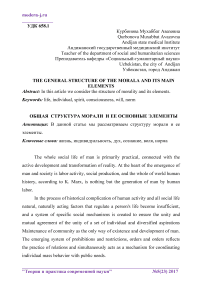The general structure of the morala and its main elements
Автор: Qurbonova M.A.
Журнал: Теория и практика современной науки @modern-j
Рубрика: Основной раздел
Статья в выпуске: 5 (23), 2017 года.
Бесплатный доступ
In this article we consider the structure of morality and its elements.
Life, individual, spirit, consciousness, will, norm
Короткий адрес: https://sciup.org/140271598
IDR: 140271598
Текст научной статьи The general structure of the morala and its main elements
The whole social life of man is primarily practical, connected with the active development and transformation of reality. At the heart of the emergence of man and society is labor activity, social production, and the whole of world human history, according to K. Marx, is nothing but the generation of man by human labor.
In the process of historical complication of human activity and all social life natural, naturally acting factors that regulate a person's life become insufficient, and a system of specific social mechanisms is created to ensure the unity and mutual agreement of the unity of a set of individual and diversified aspirations Maintenance of community as the only way of existence and development of man. The emerging system of prohibitions and restrictions, orders and orders reflects the practice of relations and simultaneously acts as a mechanism for coordinating individual mass behavior with public needs.
Thus, the initially emerging morality appears in the form of really folding and practiced forms of behavior and social relations, when the aspect of its appraisal and evaluation aspect is not yet singled out as a special sphere of consciousness, a model of ideal obligation, opposed to real reality. In fact, morality is exhausted by the realm of morals-the real practice of people's relationships.
However, in connection with the reflexive nature of human activity, which generates its awareness and at the same time increasingly determined by it, and the unfolding process of deepening the differentiation of society with its inherent diversity and clash of interests, morality seems to "exfoliate" from real practice and people's behavior And moves to an ideal, indebted sphere. It as it becomes over the collision of individual corporeal interests as an awareness and expression of the most profound and essential needs of social development.
As a result, the moral life of a person and society acquires a multilayered complex structure, the main elements of which are moral practice, the real field of really practiced individual-mass forms of behavior and folding relationships, and moral consciousness as an expression of the ideal obligation to which Oriented.
At the same time, it goes without saying that in real life activity and consciousness mutually encourage and mutually reinvigorate each other, existing through one another. However, in scientific analysis, morality can be considered either as a sphere of real-practical relations regulating individual mass behavior and incarnating in them, Or as a special sphere of spirit, consciousness and will. And in ordinary life, it is far from the same: to know the norms and principles of moral behavior and to act in accordance with them.
Therefore, in ethical literature, it is customary to differentiate between morality and moral activity and attitudes and moral consciousness. At the same time, moral relations are considered precisely as an intermediary link, what determines activity and activity, consciousness, as well as what is directly reflected in them.
Moral activity is a concept that is used in ethics to identify the meaning that is inherent in all other types of human activity. It denotes not a particular sphere of activity that has object-specific certainty and specificity - for example, labor, scientific, and art - but the social significance of any person's activity. Any moral action includes the work of consciousness - mental, sensual, volitional components, but at the same time does not reduce only to them, because it assumes its objectification, objectification in real life as a certain result.
True, it is possible to identify in a holistic complex of a single human activity that which is directly subordinate to the creation of good in its goals and content and is motivated exclusively by moral motives. This "pure" moral activity - the provision of humanitarian assistance, philanthropy, moral preaching and moral education. However, in the broadest sense of the word, all human activity is understood as a moral activity, since it has a socially significant meaning, it is subject to moral demands, and therefore it is subject to moral evaluation.
Used sources:
-
1. Gorelov AA, Gorelova TA Ethics: a study guide. Flint Publishing; MPSI, 2011.
-
2. Apresyan RG Ethics: A textbook for university students. M., 1999.
-
3. Berdyayev N.A. The origins and meaning of Russian communism. M., 1990.
-
4. Weber M. Protestant ethics and the spirit of capitalism. M., 2002.
-
5. The Universal Declaration of Human Rights, approved and proclaimed by the UN General Assembly on December 10, 1948.
-
6. Guseinov A.A. Ethics: A textbook for students. M., 2006.
-
7. Ivanov V.G. Ethics: A manual for students. M., 2005.
-
8. The moral code of the builder of communism. M., 1965.
-
9. Ethics / edited by TV Mikeshina and Ya.S. Yaskevich. Minsk, 2006.
-
10. Ethics: The Encyclopaedic Dictionary. M., 2001.
Список литературы The general structure of the morala and its main elements
- Gorelov AA, Gorelova TA Ethics: a study guide. Flint Publishing; MPSI, 2011.
- Apresyan RG Ethics: A textbook for university students. M., 1999.
- Berdyayev N.A. The origins and meaning of Russian communism. M., 1990.
- Weber M. Protestant ethics and the spirit of capitalism. M., 2002.
- The Universal Declaration of Human Rights, approved and proclaimed by the UN General Assembly on December 10, 1948.
- Guseinov A.A. Ethics: A textbook for students. M., 2006.
- Ivanov V.G. Ethics: A manual for students. M., 2005.
- The moral code of the builder of communism. M., 1965.
- Ethics / edited by TV Mikeshina and Ya.S. Yaskevich. Minsk, 2006.
- Ethics: The Encyclopaedic Dictionary. M., 2001.


